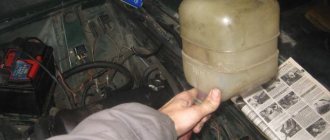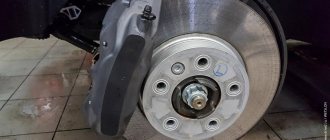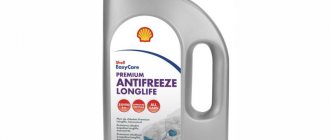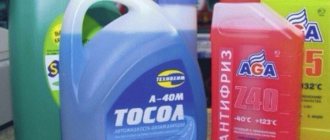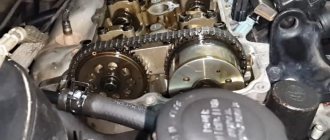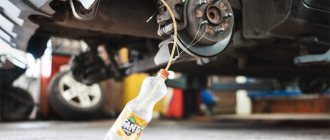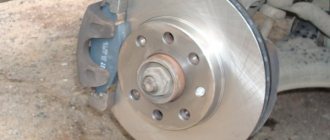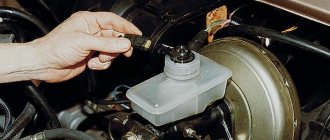Here are some signs indicating that it is time to replace the antifreeze in your VAZ 2107. These include:
- Frequent overheating , constant operation of the cooling fan, and steam emanating from the radiator may indicate a breakdown in the cooling system or excessive contamination of the antifreeze. Such situations most often occur in the summer, but sometimes they can occur in the winter.
- The appearance of an unpleasant odor in the radiator or expansion tank. In normal condition, the coolant has no odor; its appearance is a signal of the need for urgent replacement.
- A significant change in the color of antifreeze and its thickening indicate the presence of a large amount of pollutants.
The presence of one or more of the described signs indicates that it is time to change the coolant.
Replacement frequency and what antifreeze to fill
The volume of the cooling system in the VAZ-2107 is 9.85 l . Standard antifreeze, which most car enthusiasts use, needs to be replaced every 2 years or after 60 thousand km. Please note that some other brands have different recommendations. Be sure to read all accompanying information.
- If your car was manufactured before 1998 , you can use regular antifreeze or class G .
- For cars manufactured from 1998 to 2002, regular antifreeze and class G .
- Cars manufactured from 2003 to 2012 G12+ or G12++ class coolants
How to fill in new coolant
VAZ instructors recommend using AM and A40M antifreeze for models 2109. In the event that it is impossible to use an inspection hole, as an option, the car owner can be advised to purchase special taps that are installed instead of drain plugs. A hose is attached to these taps, and the liquid already circulates through it. This device greatly simplifies the process of replacing coolant.
Work on replacing antifreeze is carried out only on a cold engine.
So, to fill in antifreeze, you need to do the following:
- First, you need to tighten the drain plug located on the radiator. You also need to remove the plug from the cylinder block. We untie the clamp of the antifreeze outlet hose and disconnect it from the throttle fitting. Then you need to hold this hose with your hand. We fill the new antifreeze into the tank. You need to fill in about four to five liters. Return the hose to the fitting. Tighten the clamp on the hose. Again you need to fill the antifreeze into the expansion tank. You need to pour until the liquid reaches the maximum mark. In total, about seven to eight liters of antifreeze should be spent. Next, you should replace the tank cap. Then return the ignition module. You should start the car and warm up the engine to operating condition. Next, turn off the engine and again you need to measure the antifreeze level. If the coolant level does not reach maximum mark, then you need to add more antifreeze
When pouring antifreeze, several important points should be taken into account:
- As already mentioned, all work should be carried out exclusively with a cooled engine. When draining the coolant, there is a risk of moisture getting on the generator. To prevent this from happening, it is necessary to protect the generator before draining. Be sure to check the antifreeze level after running the engine. If the fluid is below the maximum mark, then over time the engine will begin to overheat, which can accelerate the process of wear and tear. It is not recommended to allow antifreeze and antifreeze to mix. Liquids differ in composition, so the quality of their work when mixed will be significantly reduced
The engine cooling system is an important part of every car, through which the normal operation of the engine is ensured. A significant part of the cooling system is devoted to refrigerant or coolant, which can be presented in the form of antifreeze (in most cases), antifreeze or distilled water. During the operation of any car, including the VAZ 2107, it is important to promptly replace the coolant, which will improve the efficiency of the cooling system. In this issue, we will look in more detail at how to correctly replace antifreeze on a VAZ 2107, what is required for this and where to start.
What is needed to replace antifreeze?
To carry out the operation, you need to prepare all the instruments . But first of all, choose a convenient place to work. An overpass or pit should be considered optimal. In this case, you need to choose the location so that the front of the car is slightly higher than the rear.
You need to stock up:
- A set of keys.
- A container for draining old fluid.
- Fresh antifreeze (10 liters).
- A special product with which we will remove dirt from plugs, bolts and other parts.
- Flat and figured screwdriver.
- Hose for the drain hole.
- A funnel with which we will fill in the new liquid.
When to replace the coolant
If you have carefully read all the documents supplied with the car, then you undoubtedly know that a process such as replacing antifreeze is carried out when the mileage reaches forty-five thousand kilometers, or once every two years. It depends on the intensity of use of the car
. Do not disdain advice from the manufacturer! If the antifreeze is not replaced in time, this may result in engine overheating.
Replacing antifreeze in a VAZ-2107
Wait until cools down completely . Antifreeze is a toxic substance, so it is better to carry out work in a well-ventilated area or in the open air. Follow basic safety rules when working with toxic substances.
Draining old antifreeze
First of all, remove the engine crankcase protection, if any. In many cases, the bolts are in a rusty state and are therefore quite fragile. This requires care when dismantling. It is best to use special tools that facilitate the process of freeing soured bolts. Among such products are, for example, WD-40 or EFELE UNI-M Spray. After this, in the cabin we move the heater control lever to the maximum position. In this case, there is no need to start the heater.
Next, open the filler neck of the radiator and expansion tank. This operation will allow you to drain the old antifreeze much faster. Further actions depend on the radiator model. The original radiators of the latest models have a special tap . Please note that it is susceptible to souring, so it may require special treatment.
Radiators of older models require unscrewing the fan switch off sensor (it is located on the inside) or disconnecting the hose, which is located on the lower pipe. Next, remove liquid from the internal circuit of the cooling system. The drain plug looks identical to the 13 bolt; you need to unscrew it and drain all the liquid through the hose that you prudently stocked up on.
We release the expansion tank by unfastening the fastening belt and lifting the container 30–40 centimeters up. This simple method stimulates the flow of liquid into the radiator and then into the prepared container.
Flushing the cooling system
This stage is not always . But in some cases it is simply necessary. For example, if you decide to change the brand of antifreeze and your choice does not match the chemical composition with the previous decision. Flushing is also necessary in cases where there are significant contaminants or plugs that impair engine performance. It is recommended to carry out this operation even when your car is a new purchase (especially if you bought a used car). Don't forget about the expansion tank . All hoses are removed from it, it is separated from the fastenings, and then thoroughly washed from the inside.
Adding fresh antifreeze
The last stage of the entire operation is pouring fresh fluid . First of all, disconnect the hose from the intake manifold fitting, which is located under the carburetor. If the car is equipped with an injection engine, it is necessary to disconnect the receiver heating hose. This will prevent air pockets from occurring. The hoses are secured with clamps, so the work requires the use of a screwdriver. After this, new coolant is poured into the expansion tank. The liquid level should be approximately 3–4 centimeters above . After the operation is successfully completed, you will be able to notice that antifreeze is flowing out of the previously opened hole on the intake manifold or receiver. Immediately after this, put the hose in place and tighten it with a clamp.
Signs of aging antifreeze
Antifreeze, like any other working fluid in a car, has its own resource. To determine that antifreeze needs to be replaced, you need to understand what signs indicate this.
Firstly, you should pay attention to the temperature conditions of the engine. If the power unit is constantly overheating, the cooling fan is constantly running, the coolant temperature needle is in the red zone, and steam is coming from the radiator - you must first check the condition of the cooling system and the antifreeze itself. In the case of the “seven”, such problems usually arise in the warm season, and in worst cases, in winter.
Secondly, the produced antifreeze has an unpleasant odor. You can smell it from the radiator or expansion tank. It should be understood that if the coolant begins to smell, then all permissible periods for its replacement have already passed. It is possible that in this case it may be necessary to repair some elements of the cooling system.
The third thing you need to look at is the color and consistency of the antifreeze. Slight darkening of the coolant is not a sign of a necessary replacement, but a strong change in color and thick consistency of the antifreeze indicates that a large amount of contaminants has accumulated in it.
If one or more of the described symptoms is present, the coolant must be replaced immediately, regardless of whether it is fresh or not.
Possibilities for upgrading the machine
In the nineties of the last century, many owners of VAZ 2107 cars, not particularly counting on gas stations, installed an additional tank in the car. This is much more convenient than pouring fuel from cans. Typically, such a container was located behind the rear seat in the trunk. It could have different sizes, and accordingly they had the appropriate capacity.
The driver in those days often encountered empty gas stations, and the additional volume of the fuel tank greatly expanded the capabilities of the car. Knowing the required amount of technical fluids is necessary for routine maintenance of the engine and other systems.
How many liters of antifreeze
Since the volume of radiators, channels, engine, cooling jackets are different, then, accordingly, the volumes are different for different brands. Therefore, we present data for certain cars.
How much antifreeze or antifreeze is needed in the car cooling system:
- VAZ 2101 - 8 liters;
- 2102 - 8 liters;
- 2103 - 8.6 liters;
- 2104 - 8.5 liters;
- 2105 - 8.6 l;
- 2106 - 8.6 l;
- 2107 - 8.6 l;
- 2108 - 7.8 l;
- VAZ 2109 - 7.8 l;
- VAZ 21099 - 7.8 l;
- VAZ 2113, 2114, 2115 - 7.8 l;
- VAZ 2110, 2111, 2112 - 7.8 liters for both 8 and 16 valve engines;
- 21213 “NIVA” - 10.7 l;
- VAZ 2111 “OKA” - 4.8 liters;
- Lada Granta 2190 - 7.8 l;
- Lada Kalina 23009 - 7.84 l;
- Lada Priora - 7.84 l;
- Lada Vesta - 7.84 liters;
- Lada Xray (X Ray) - 7 l.
Volumes of antifreeze or antifreeze for UAZ cars:
- UAZ 469 - 13 l.;
- UAZ Patriot - 12 l.;
- UAZ 452 - 13.4 l.
Volumes of antifreeze Gazelle:
- Gazelles of all modifications: from 9.7 to 11.5 liters.
- Gazelle 3110 - 10.5 l.
Replacing coolant requires knowledge not only of the process itself, but also of the safety rules for carrying out work. For example, you cannot change the fluid when the engine is hot, that is, you cannot open the engine cooling radiator cap when the antifreeze, antifreeze or water in the system is hot. You can get burned by steam or splashing coolant.
The cooling fluid must be replaced periodically in compliance with the rules and regulations. You also need to know that you cannot mix antifreeze with antifreeze; you can dilute it with water, but this will deteriorate the properties of the coolant.
For cars of the VAZ family, it is recommended to change the coolant after a mileage of 60 thousand km. Some people are used to changing them yearly, for example, they replace antifreeze or antifreeze every 2-3 years.
For almost thirty years, the Volzhsky Automobile Plant produced the “Seven” - one of the most common cars in our country. VAZ 2107 is a luxury sedan version of the previous fifth model. By the standards of the end of the last century, the car is quite reliable, comfortable and, most importantly, inexpensive. The technical characteristics of this car were at a fairly high level for its time.
The car was equipped with a one and a half liter gasoline engine, and its tank volume of 39 liters allowed it to travel over 534 km with a minimum consumption of 7.3 liters per 100 km. When driving around the city, this distance decreased to 379 km. The power unit was filled with motor oil, and the crankcases of other mechanisms were filled with special transmission oil. The filling tanks of the VAZ 2107 car had a sufficient volume to ensure trouble-free operation of the engine and other systems.
Operating principle
When the engine starts, antifreeze circulates under the action of a water pump. Initially, its movement is carried out along a small contour (circle) with the thermostat closed. However, it does not enter the radiator. This allows you to speed up the process of warming up the engine to optimal operating temperature.
When the antifreeze heats up, the increase in its volume is compensated by the expansion tank. It is into this that the hot auto fluid enters, which then returns to the cooling circuit.
After the engine warms up to a temperature of 85-95 degrees Celsius, the thermostat opens and the technical fluid begins to circulate through the radiator, that is, in a large circle. In this case, the cool antifreeze located in the radiator enters the power plant jackets and cools it to the optimal temperature.
In the event of further heating of the power plant (if it does not have time to cool), at the command of the temperature control sensor, an electric fan is turned on, which forcibly cools the radiator and motor until the liquid has cooled to a certain value, after which it turns off. In this way, the required temperature of the technical solution and the engine is constantly maintained.
During cold weather, you can direct part of the hot antifreeze to the “stove” radiator. This ensures heating of the internal volume of the vehicle due to excess heat taken from the hot substance.
Draining antifreeze from the radiator
The replacement process itself is very simple.
Before you start draining the old liquid, be sure to move the heating tap control lever to the rightmost position, only after that the tap will open. The expansion tank cap is unscrewed, and the filler cap is also unscrewed.
We carefully inspect the lower left corner of the radiator, there we find the drain plug and unscrew it, pouring the liquid into the prepared container.
We also find a plug on the engine itself; it is unscrewed with a key to “13”. When you have already drained all the liquid, you need to screw back all the drain plugs.
How to drain coolant
Prepare the following tools:
- head or key No. 13;
- socket wrench No. 12;
- flat screwdriver;
- a bottle, jar or other container for draining remaining liquid;
- antifreeze or antifreeze.
First of all, turn off the engine and wait until it cools down completely.
. You can start replacing the coolant only with a cold engine.
Open the hood of the car. Find the radiator and unscrew its cap. For those who are carrying out this procedure for the first time, we advise you to prepare a container for the unscrewed elements in advance. Open the tank, place the container that you have prepared for the remaining liquid. Unscrew the radiator cap and bolt and drain the antifreeze.
Antifreeze or antifreeze?
Now you’ll figure out how to drain antifreeze from a VAZ-2107. But what to pour into the cooling system if there are two types of liquids on the market - antifreeze (blue) and green). But in fact, you just need to go into the terminology. In fact, antifreeze is antifreeze (literally “against the cold”). But those liquids that are called antifreeze are produced using domestic technology, and “antifreeze” is produced using imported ones. In fact, any alcohol can be called antifreeze, since it does not freeze at earthly temperatures. But one feature cannot fail to be noted - imported analogues of coolant are of much better quality and have a longer service life. Therefore, it is preferable to use liquids under the trade name “antifreeze”, despite the fact that it is 100-200 rubles more expensive than antifreeze (10 liter canister).
Bleeding the system
How to drain antifreeze from a VAZ 2107 block is now extremely clear. But then you need to carry out the reverse procedure - fill it. And this is more difficult, since there is a risk of air jams. To prevent this from happening, you need to follow simple rules. Close all drain holes and pour liquid into the radiator neck. Squeeze the pipes to force out as much air as possible. Then close the cap and pour antifreeze into the expansion tank. Start the engine and warm it up to operating temperature. Please note that in this case it is necessary that the heater valve is open and the rear of the machine is lower than the front. As necessary, add antifreeze to the tank and squeeze the pipes with your hands to force out excess air. During the procedure, the pipe from the throttle valve must be disconnected to control the filling of the system.
Why is it necessary to change antifreeze?
In any modern car, antifreeze circulates in a circle, taking heat from the engine jacket. It is worth noting that there is no need to unscrew the cap of the expansion tank before draining the antifreeze from the VAZ-2107. Injector or carburetor - it doesn’t matter, the circuit is identical. The first "sevens" used water as a liquid. But it has a lot of disadvantages - it freezes at sub-zero temperatures outside, forms scale on the walls and in the pipes, and damages the pump.
Antifreeze is devoid of all these shortcomings, but still has several nuances. The service life is limited - no more than two years, or 90-100 thousand kilometers. Antifreeze is a complex compound that contains a large number of additives. And due to temperature changes, these additives evaporate and lose their properties. The result is that the boiling point increases, the viscosity decreases, and there is a risk of pump breakdowns.
Operating standards for technical fluids
Already at the development stage, the manufacturer determines the parameters of the machine, which are refined during the testing process. So, in the described car, model VAZ 2107, the volume of the fuel tank corresponds to the size of the niche in the trunk behind the right wheel arch. Crankcases of other mechanisms contain the following quantities of operating fluids:
- engine – 3.75 liters of engine oil;
- cooling jackets, radiator and expansion tank - 9.85 liters of antifreeze;
- manual gearbox housing – 1.35 liters of TAD-17 oil;
- rear axle - 1.3 liters of the same oil;
- hydraulic clutch – 0.2 l of brake fluid;
- steering gear housing – 0.215 l of hypoid oil;
- closed container for windshield washer - 2 liters of water or special liquid.
Operating standards for the VAZ 2107 car were developed by the manufacturer for organizations and enterprises. Knowing the volume of fuel that the tank or crankcases of other mechanisms hold, it is easy to calculate the amount required for travel.
How to add new coolant
After you have emptied the expansion tank, it must be filled with new fluid. First tighten the bolt. Then fill the radiator with coolant to the mark marked “max” (“max”). Lift the tank and continue to fill in antifreeze - it should come out through the hose. Place the hose on the radiator and continue filling.
Turn on the engine and wait for the fan to start. Let it run for a few minutes and turn off the engine. Check the coolant level. Tighten the radiator cap and close the cap, then close the hood.
Lack of fluid and consequences
The disadvantage of antifreeze is rapid evaporation; you also have to solve the problem of leakage.
It happens that liquid can be seen leaking under the car. There are also cases when it goes into the car interior, this indicates a breakdown of the heater taps, they need to be replaced. In addition, smoke may be emitted from the exhaust pipe. This occurs due to a faulty cylinder head gasket. When antifreeze boils, you need to fix the problem in time ; you need to drain it and change it.
If you do not give significance to the signs that appear and continue to move on, then the consequences can be very sad. If the fluid disappears from the tank, the motor may overheat when the mark reaches the minimum value.
Causes of malfunction
How to determine what is wrong if antifreeze is leaking? There can be many reasons for malfunctions, so we will present only the main ones.
- Carefully inspect the clamps. It is possible that the cause of the leak is a clamp that is not fully clamped.
- Inspect the pipes for cracks. If a crack is found, replace the pipes.
- Radiator damage. This is a mechanical problem. If the damage is minor, it can be repaired by gluing or welding. Gel sealant will be a good help in identifying the location of the leak.
- Another reason for antifreeze leakage is pump wear. The solution is to replace it, as in the case of pipes.
- Coolant leak near the head. There is no solution at home - you need to contact a service station, since a qualified inspection and disassembly of the engine is required.
- If you find antifreeze stains under the driver's or passenger's floor mat, it means it is leaking into the cabin. You should also contact a service station with this problem.
